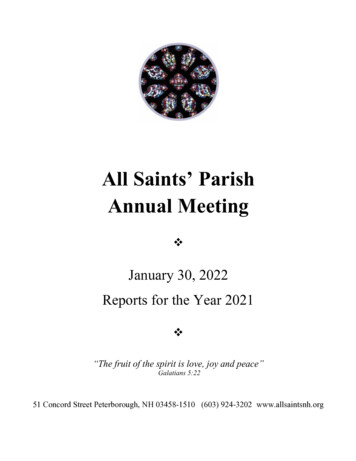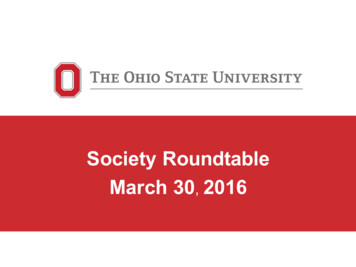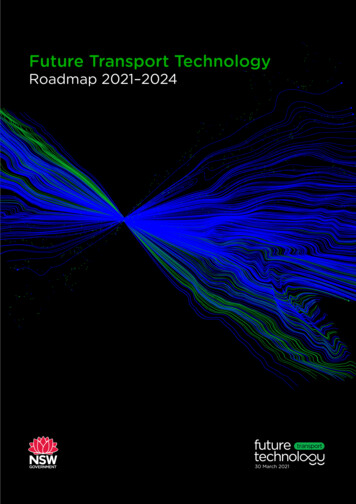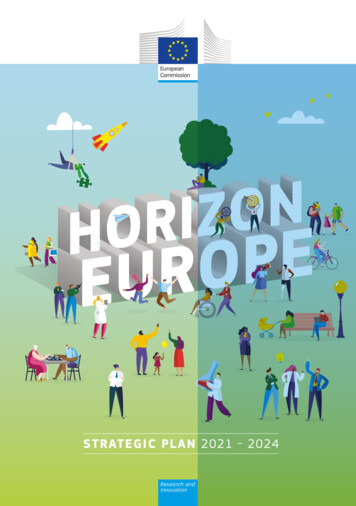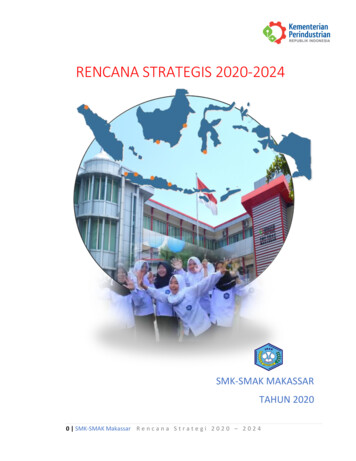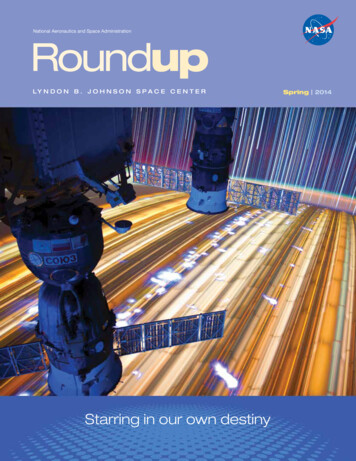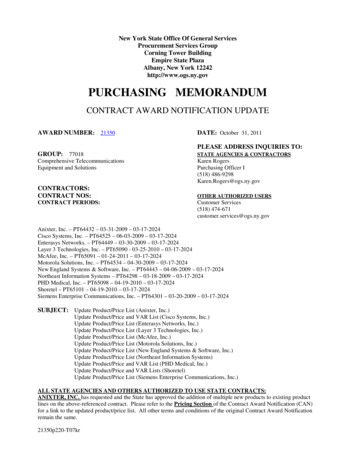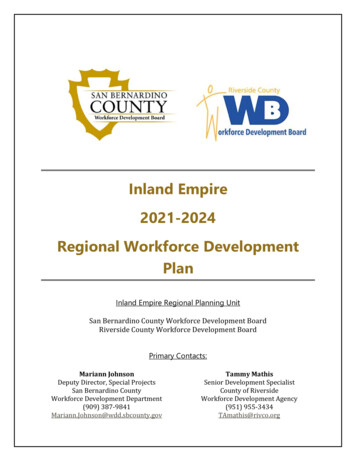
Transcription
Inland Empire2021-2024Regional Workforce DevelopmentPlanInland Empire Regional Planning UnitSan Bernardino County Workforce Development BoardRiverside County Workforce Development BoardPrimary Contacts:Mariann JohnsonDeputy Director, Special ProjectsSan Bernardino CountyWorkforce Development Department(909) 387-9841Mariann.Johnson@wdd.sbcounty.govTammy MathisSenior Development SpecialistCounty of RiversideWorkforce Development Agency(951) 955-3434TAmathis@rivco.org
Table of ContentsExecutive Summary . 3I.Introduction . 4Inland Empire Region . 4Inland Empire Regional Planning Unit and its Vision. 4Future of Work. 5Impacts of COVID-19 . 6II.Regional Workforce Plan Development Process . 7Analytical Overview of the Region . 9Current Employment, Largest Industries and Most Common Occupations . 9Inland Empire Labor Force Participation . 13Unemployment . 17Labor Market Demand . 19III.Fostering Demand-Driven Skills Attainment . 28IERPU Goals and Regional Indicators. 28In-Demand Industry Sectors and Occupations. 30Implementation of Regional Sector-Based Career Pathways . 32IV.Enabling Upward Mobility for All Californians. 36High Road Workforce System. 36V.Equity and Economic Justice . 37Aligning, Coordinating, and Integrating Programs and Services . 41System Alignment . 41VI.Conclusion. 43Appendix A: Stakeholder and Community Engagement Summary . 44Appendix B: Inland Empire Regional Workforce Goals . 49Appendix C: Public Comments Received that Disagree with the Regional Plan. 56Appendix D: Signature Pages . 57
Executive SummaryAs part of a four-year planning process, the Inland Empire Regional Planning Unit (IERPU) hasdeveloped this regional workforce development plan to address the needs of the Inland Empirecommunity. The purpose of the planning process and this plan is to develop equitable, regional,sector-based career pathways in target sectors, ensuring access and inclusion for all of the region’sresidents, businesses and organizations. The counties of San Bernardino and Riverside arerecipients of Workforce Innovation and Opportunity Act (WIOA) funding, and so the region ensuredthis process and plan document were in alignment with the State of California WorkforceDevelopment Board (CWDB)’s Unified Strategic Workforce Development Plan.The region began the planning by conducting an inclusive process gathering input for this plan frompartner organizations, employers and other stakeholders in a series of interactive virtual meetingsheld between December 2020 and January 2021. Participants were asked to provide ideas for howthe region's workforce system can meet the needs of the community in five key areas: respondingto COVID-19; developing career pathways to the middle class; providing access and inclusion for all;preparing for the future of work; and building a high road workforce system. The IERPU workedtogether as members of both workforce development boards, the San Bernardino CountyWorkforce Development Board and the Riverside County Workforce Development Board, toprocess the input received and incorporate it into the plan.A detailed workforce and economic analysis was provided to the region by the University ofCalifornia, Riverside. The regional labor market information and workforce demographic dataappears in Section II of the report and provided an empirical grounding for the planning process.The data reaffirmed the region's selection of three target sectors of Healthcare, Manufacturing andTransportation and Logistics due to the current demand and expected growth over the next severalyears.Five key goal areas were developed as a result of the planning process and form the backbone ofthis workforce development plan: 1) Regional Sector-Based Career Pathways, 2) High RoadWorkforce System, 3) Access and Inclusion for All, 4) Future of Work and 5) Regional Coordinationand Alignment. Several specific goals that address the region's response to COVID-19 were alsodeveloped and are highlighted where they intersect with the areas listed above.Sections III-V provide additional details on how the region intends to operationalize its goals,including the development of four regional indicators. Each section discusses how the plan alignswith the CWDB's priorities to foster demand-driven skills attainment, provide high roademployment, ensure equity and economic justice and align/coordinate services across the region.Appendices provided at the end provide additional documentation on the process, how the planwill be executed and public comment received about the plan.3
I.IntroductionInland Empire RegionThe Inland Empire region consists of San Bernardino and Riverside Counties in Southern California.Representing a richly diverse region of the state, among San Bernardino County’s population of2,180,085, over half of the residents are Hispanic or Latino, over 9% are Black, 8% are Asian andabout 3.6% are of two or more races. 1 The county makes up more than half of the regiongeographically, and is the largest county in the U.S. San Bernardino County covers over 20 thousandsquare miles and a vast majority of its residents live in the southeastern corner of the countyknown as the Valley Region. 2 Over 80% of the rest of the County land is under federal jurisdictionincluding areas like the Mojave National Preserve and the San Bernardino National Forest.Riverside County, a contiguous county to the south of San Bernardino, includes a smaller amount ofland but is home to more residents. With about 53% of the Inland Empire region’s population(2,470,546) calling the county home, just about half of the residents are Hispanic or Latino, over 7%are Black, another 7.2% are Asian and about 3.6% are of two or more races. Including the SanJacinto Mountains, Riverside County covers a little over 7,200 square miles with large swaths ofuninhabited natural lands. 3 Together, the two counties make up the scenic, culturally diverse anddynamic Inland Empire region that has a thriving economy and a need for a strong, high-roadworkforce development system to ensure there is a path to the middle class for all.Inland Empire Regional PlanningUnit and its VisionThe Inland Empire Regional Planning Unit(IERPU) is comprised of the SanBernardino County WorkforceDevelopment Board (SBCWDB) and theRiverside County Workforce DevelopmentBoard (RCWDB). The two WDBs of theIERPU created a vision statement for theregion to set the strategic direction forplanning and implementation. See Figure 1for the IERPU vision.Figure 1: The IERPU Vision forWorkforce DevelopmentThe workforce development vision for the InlandEmpire is a reinvented regional system thatengages business and industry in identifying highquality jobs and designing training programs toprepare a competitive workforce. The IERPUpartners will prepare the workforce by ensuringthat services address barriers to employment andpromote educational attainment to createpathways from dependency to prosperity.Census (2020). QuickFacts: Riverside County, California; San Bernardino County, California. Retrieved ornia/AFN120212.2 San Bernardino County (2020). County Profile. Retrieved file/.3 Census (2020).14
With this vision in mind, the regional partners across both counties and boards developed severalobjectives for the development of the Inland Empire 2021-2024 WIOA Regional WorkforceDevelopment Plan: To create strategies that develop equitable, regional, sector-based career pathways in targetsectors, ensuring access and inclusion for all of the region’s residents, businesses andorganizationsTo learn from what worked and identify what still needs to be done in response to COVID19, both in the short- and long-termTo build a high-road employment system, leveraging the support of high-road employers tobuild robust career pathways that lead to family-sustaining wagesTo increase efficiencies, reduce duplication and improve overall quality of services throughsynergistic regional cooperation and mutually reinforcing strategiesTo consider how automation, new technologies, the gig economy and related “future ofwork” concepts will impact the regional economy, targeted sectors and jobsFuture of WorkIn addition to regional sector-based careerpathways, high road employment, access andinclusion and regional coordination, a fifthoverarching concept, the future of work, wasaddressed by the region and its partners.Changes to the economy and jobs brought aboutby automation, remote working and the gigeconomy, for example, are highly likely over thenext four years. In 2017, the McKinsey GlobalInstitute analyzed individual activities withinjobs and found that as much as 50 percent oftime spent on activities across all sectors could be automated with current technology. 4 A morerecent survey of businesses conducted by McKinsey in June 2020 of 800 executives found that over67 percent have accelerated their adoption of automation due to the COVID-19 pandemic. 5“Jobs Lost, Jobs Gained: Workforce Transitions in a Time of Automation,” McKinsey Global Institute,December -ofwork-will-mean-for-jobs-skills-and-wages5 “What 800 Executives Envision for the Postpandemic Workforce,” McKinsey & Company, Sept ostpandemic-workforce45
Automation is only one facet, however, and the growthof the gig economy is another. When last analyzed bythe Bureau of Labor Statistics (BLS) in 2017,“contingent workers” (including independentcontractors, on-call workers, temp workers andworkers provided by contract firms) made up 3.8% ofall workers at 5.9 million, down from 4.1% in 2005when the survey was last conducted. 6 The FreelancerUnion calculated a much higher figure for gig workersat 57.3 million in 2017, or 37% of the workforce,staying relatively consistent at this number through2019. 7 The BLS study has been scrutinized for usingsurvey questions that may have left out manycontingent workers and the Freelancer Union, whoworks with gig work platform Upwork on their research, may have a bias toward overestimatingthe number of gig workers. 8 This probably means the actual number of gig or contingent workerslikely falls somewhere between the two figures. In any case, the number of workers engaged in thegig economy is considerable, nationally and also in the Inland Empire region.Impacts of COVID-19As the Inland Empire continues to manage a public health response to the COVID-19 pandemic, aneconomic response has also been necessary in light of many business closures and reductions inearly 2020. Workers and families were significantly impacted by the losses of income, childcare andin-person schooling while trying to keep themselves safe from the virus. Individuals in trainingprograms saw delays, shifts to virtual classes or outright cancellations of their program, impactingtheir ability to upskill. County staff offering employment services to the community had to quicklypivot to virtual services and other means to safely continue to provide services. The multiple layersof challenges faced all at once are likely to have long-term impacts, even as a vaccine is nowbecoming more available and the region is plotting a course to economic recovery.There are a few potential long-term impacts the region considered in relation to the pandemic hit.First, workers who lost their job looked to the gig economy to replace their income. Many of thesejobs are not high-quality jobs and these workers will need assistance in charting a path and gettingsupport in obtaining a better job. Second, there was a tremendous increase in remote workingacross the region. For some, this actually may have provided a higher degree of work-life balance,but for others, it proved to be a difficult transition and exacerbated inequities related to access totechnology and reliable internet access. It is likely that some businesses will choose to keep more of“A Look at Contingent Workers,” Bureau of Labor Statistics, September -workers/home.htm7 “Freelancing in America”, Freelancers Union, October ncing-in-america/8 “Experts Puzzled by New BLS Contingent Workforce Data,” Society for Human Resource Management, June2018, tingent-Workforce-Data.aspx66
their workers working remotely, even after the pandemic is no longer a major issue due to costsavings and other efficiencies.As the restrictions on in-person gatherings loosen and workplaces reopen, bringing workers backon the job, as well as participants back in for workforce services, brings in a third potential longterm impact – new health and safety policies in the workplace. This might include new regulationson how workplaces are designed for the sake of physical distancing, policies about mask-wearingand/or requiring “workplace infection control plans”. 9 With these potential long-termdevelopments in mind, the region considered how to incorporate the impacts of COVID-19 on theeconomy and jobs into its workforce development strategies.Regional Workforce Plan Development ProcessThe IERPU developed this plan as mandated by the Workforce Innovation and Opportunity Act(WIOA), with guidance provided by the State of California’s Workforce Development Board viaDirective WSD20-05 and in alignment with the CWDB Unified Strategic Workforce DevelopmentPlan. The process included initial planning and document review, stakeholder and communityinput, plan development and public posting, and regional leadership approval and finalization.These four phases are described below.Initial Planning and Document ReviewStaff members of the IERPU, which includes both San Bernardino and Riverside Counties, met tocreate a process for developing the plan, scheduling partner input meetings, setting dates for plandevelopment and a process for regional leadership review and finalization. The prior 4-yearregional plan and modification documents were reviewed for historical reference and documentsrelated to current programming and services across the region were gathered for analysis. Guidedby a plan outline, the IERPU began gathering input from stakeholders and community partners.Stakeholder and Community InputA total of nine virtual meetings were scheduled to gather stakeholder and community input for theregional plan. AJCC MOU Partners, RCWDB members, SBCWDB members, regional employers andnonprofit community partners all took part in these meetings as detailed in Appendix A. In thesevirtual meetings, participants were able to give input via breakout sessions covering five areas:COVID-19, Career Pathways to the Middle Class, High Road Employment System, Access andInclusion and Future of Work. These highly engaging sessions provided input into the design of theregional and local plans, particularly in developing goals, tactics and indicators. Meetings werefollowed by an online survey that asked for feedback on each meeting as well as provided anopportunity for additional input for the plan.Feedback from participants in the region is gathered on an ongoing basis by two primary methods –participant surveys and focus groups. In these processes, participants are asked questions such as“What are your primary reasons for visiting the AJCC?”, “Share your experience with the service“Former OSHA Head Talks Biden’s Executive Order on Workplace Safety”, National Public Radio, January 23,2020, afety97
provided by the AJCC including your interaction with staff.” and “What other resources and serviceshave you been referred to by staff at the AJCC?” The feedback received is reported back to theoversight and coordination bodies in the region for incorporation into planning. A few examples offeedback from participants in these processes that have been incorporated include: Include a description of the AJCC system partner services (to participants)Add online workshops for participants to accessAdd networking opportunities for job seekers to engage with employersPlan Development and Public PostingBetween January and February 2021, the plan was written based on state guidance, SBCWDB andRCWDB priorities, staff expertise and the input received from all stakeholders. After an initial draftwas reviewed and approved by both WDBs in February 2021, the plan was then posted for publiccomment for 30 days.Finalization Regional Leadership ApprovalAfter the public posting period, the draft plan was reviewed in light of feedback received andupdated accordingly (see Appendix C). The last step in the process was approval of this final plan bythe workforce development boards and boards of supervisors for each county. The dates ofapproval from each body are below: April 14th, 2021: San Bernardino County Workforce Development BoardApril 20th, 2021: San Bernardino County Board of SupervisorsApril 21st, 2021: Riverside County Workforce Development BoardApril 27th, 2021: Riverside County Board of SupervisorsPlease see Appendix D for signatures representing these oversight bodies.8
II.Analytical Overview of the RegionIn the following section, an analytical overview of the Inland Empire region is provided. Theanalysis was provided to the region by the University of California Riverside (UCR) Center forEconomic Forecasting and Development. For most of the subsections here, data was only availablethrough 2019; however, the region considered the economic impacts of the pandemic in 2020 inthe planning process as well.The next subsection begins with a look at the Inland Empire workforce – current employment,largest industries and most common occupations. This is followed by a breakdown of the region’slabor force participation including demographics and educational attainment. Next, unemploymentis analyzed, then employer needs are described in terms of emerging demand and an occupationalskills assessment. Finally, relevant gaps between employer needs and the workforce’s qualificationsare described.Current Employment, Largest Industries and Most Common OccupationsCurrent EmploymentTotal nonfarm employment reached 2.03 million in 2019 in the Inland Empire, up 0.5% comparedto 2018. 2019 marks the year with the slowest year-over-year growth in employment in the InlandEmpire since 2014. Except for 2016, when employment increased 1.8% compared to the previousyear, other years had year-over-year employment increases of over 3% (Figure 2).Figure 2: Total Nonfarm Employment in the Inland Empire, 2014-19Numnber of 371,789,199201420152016201720182019Source: American Community Survey. Analysis by UCR Center for Economic Forecasting and Development9
Largest IndustriesIn the Inland Empire, Health Care and Social Assistance is the largest industry sector (Table 1),employing over a quarter of a million workers, followed by Retail Trade, Professional and BusinessServices, Educational Services, and Manufacturing. These five industry sectors employed over onemillion people or 52.3% of total employment in 2019, down from 53.4% in 2014. Compared to2014, these industries sector grew 12.3%, 7.1%, 13.5%, 22.0%, and 4.5%, respectively.Table 1: Nonfarm Employment and Wage by Sector in the Inland Empire, 2014-2019NUMBER OF WORKERS20142019Health care and social assistance230,994Retail tradeAVERAGE ANNUAL WAGE20142019259,436%Change12.3% 45,549 54,143%Change18.9%228,703244,9507.1% 28,503 33,42117.3%Professional and business services179,225203,38413.5% 36,768 47,83130.1%Educational services146,212178,32222.0% 42,126 49,74918.1%Manufacturing169,7611773674.5% 46,315 53,65915.9%Transportation, warehousing, andutilitiesConstruction132,736176,11332.7% 43,511 45,1333.7%140,855175,01724.3% 39,371 48,06522.1%Accommodation and food services136,901153,29612.0% 18,349 24,92935.9%Other services, except publicadministrationPublic administration91,710108,97118.8% 24,452 28,22815.4%90,907107,63918.4% 66,773 72,8739.1%Wholesale trade58,63662,2416.1% 43,002 53,57424.6%Finance and insurance53,51956,6475.8% 51,136 63,62824.4%Arts, entertainment, and recreation44,26948,2999.1% 25,466 32,58828.0%Real estate and rental and leasing39,41437,009-6.1% 35,150 53,20351.4%Information23,21725,1118.2% 52,393 51,803-1.1%Natural resources and mining22,14017,941-19.0% 30,597 36,86120.5%Total/Average1,7891,992,031,74313.6% 38,823 46,21519.0%Source: American Community Survey. Analysis by UCR Center for Economic Forecasting and DevelopmentIn 2019, except for Retail Trade ( 33,400), the average wages for the largest industry sectors paidabove the total average of all jobs ( 46,200) in Inland Empire: Health Care and Social Assistance( 54,100), Professional and Business Services ( 47,800), Educational Services ( 49,700), andManufacturing ( 53,700). The average wages of Health Care and Social Assistance andManufacturing paid 17.2% and 16.1% more than the total average of all jobs, respectively. On theother hand, the average wage in Retail Trade is 27.7% lower than the total average. PublicAdministration ( 72,900) has the highest average wage in Inland Empire. The average wageincreased in all industry sectors from 2014 to 2019 except for Information, which contracted 1.1%.Except for Manufacturing, the largest industries in the Inland Empire had sustained and gradualincreases during the period of 2014 to 2019 (Figure 3). The sustained and gradual increases aremost prominent in Health Care and Social Services and Professional and Business Services.10
Meanwhile, after years of declining employment, Manufacturing employment rebounded after2017. From 2017 to 2019, Manufacturing added 22,900 jobs, or a 14.8% increase.NUMNBER OF WORKERSFigure 3: Largest Industries by Employment in the Inland Empire, alth care andsocial assistance2014Retail trade2015Professional andbusiness ng2019Source: American Community Survey. Analysis by UCR Center for Economic Forecasting and DevelopmentLargest industry SubsectorsThe largest industry subsectors in Inland Empire are Educational Services (Primary/Secondary),Construction, Food Services and Drinking Places, Professional and Technical Services, andAmbulatory Health Care Services (Table 2). The first three subsectors each employed over 100,000workers and just under half a million workers altogether, while the other two subsectors eachemployed almost 100,000 workers. Altogether, the 15 largest industry subsectors shown in thistable employed 1.2 million workers; three in five workers in the Inland Empire work in one of these15 subsectors.In recent years, the Inland Empire has seen a tremendous growth in the Transportation andWarehousing industry, and correspondingly, Warehousing and Storage more than doubled inemployment ( 130.8%) from 2014 to 2019. On the other hand, employment in TruckTransportation declined 18.1% during the five-year period. Employment in General MerchandiseStores (-14.6%) and Food and Beverage Stores (-3.7%), both of which are client facing and contactheavy, had declined significantly. Collectively, there are 15,900 fewer jobs in these three industrysubsectors in 2019 than in 2014.11
Table 2: Largest Subsectors by Employment in the Inland Empire, 2014-2019NUMBER OF WORKERS20142019Educational AGE ANNUAL WAGE20142019178,322%Change22.0% 42,126 49,749%Change18.1%140,855175,01724.3% 39,371 48,06522.1%Food services and drinking places118,672132,93612.0% 16,593 23,44141.3%Professional and technical services74,25897,85731.8% 50,520 65,19029.0%Ambulatory health care services80,48997,52221.2% 45,959 55,34320.4%Administrative and support services96,67896,431-0.3% 25,554 29,51315.5%Hospitals79,56285,0376.9% 63,227 73,67216.5%Warehousing and storage24,23855,950130.8% 29,662 31,0254.6%Public administration46,95351,97010.7% 80,955 92,07813.7%Social assistance46,19951,65211.8% 23,459 28,92223.3%Food and beverage stores42,26040,684-3.7% 30,127 33,33910.7%Repair and maintenance30,53539,11328.1% 30,095 35,24117.1%Amusements, gambling, and recreation34,17937,0178.3% 27,285 34,78527.5%Truck transportation45,06836,893-18.1% 38,697 43,88913.4%General merchandise stores42,13135,964-14.6% 23,987 28,04716.9%1,7891,992,031,74313.6% 38,823 46,21519.0%Inland Empire OverallSource: American Community Survey. Analysis by UCR Center for Economic Forecasting and DevelopmentMost Common OccupationsThe Inland Empire has a strong Transportation and Warehousing industry, and intuitively MaterialMoving Workers (SOC 53-7000) is by far the most common occupation, with 129,100 workersemployed in this occupation in 2019. Motor Vehicle Operators is another major occupation intransportation and warehousing, employment 80,500 workers (Table 3). Other popularoccupations in the Inland Empire include: Construction Trade Workers, Retail Sales Workers, andOther Management Occupations. Altogether, the five largest occupations employed over half amillion people and the 15 largest occupations employed over a million people in 2019.Given that Health Care and Social Assistance is the largest industry by employment, healthcarerelated occupations also make the list of largest occupations in the Inland Empire. Specifically,71,300 workers are Healthcare Diagnosing or Treating Practitioners and 54,000 are Home Healthand Personal Care Aides; and Nursing Assistants, Orderlies, and Psychiatric Aides.The boom in the Transportation and Warehousing industry translates into a significant increase inthe number of people working as Material Moving Workers ( 61.0%). Meanwhile, the increase inhealthcare and related jobs are bifurcated: The number of people working as Home Health Aides,which are low paying, had increased by 278.3%, while the number of Healthcare Diagnosing orTreating Practitioners, which are significantly higher paying, increased by only 20.6%, which is stillabove the Inland Empire overall of 13.6%.12
Table 3: Most Common Occupations by Employment in the Inland Empire, 2014-2019NUMBER OF WORKERS20142019Material Moving Workers80,196Construction Trades WorkersAVERAGE ANNUAL WAGE20142019129,125%Change61.0% 23,506 27,834%Change18.4%89,260115,48729.4% 31,818 42,25432.8%Retail Sales Workers101,411104,5523.1% 16,723 22,69835.7%Other Management Occupations87,76399,11412.9% 61,708 70,27313.9%Motor Vehicle OperatorsInformation and Record Clerks75,00261,18980,54176,8767.4%25.6% 36,736 25,817 40,225 30,9679.5%19.9%Healthcare Diagnosing or TreatingPractitionersPreschool, Elementary, Middle,Secondar
together as members of both workforce development boards, the San Bernardino County Workforce Development Board and the Riverside County Workforce Development Board , to process the input received and incorporate it int o the plan. A detailed workforce and economic analysis was provided to the region by
